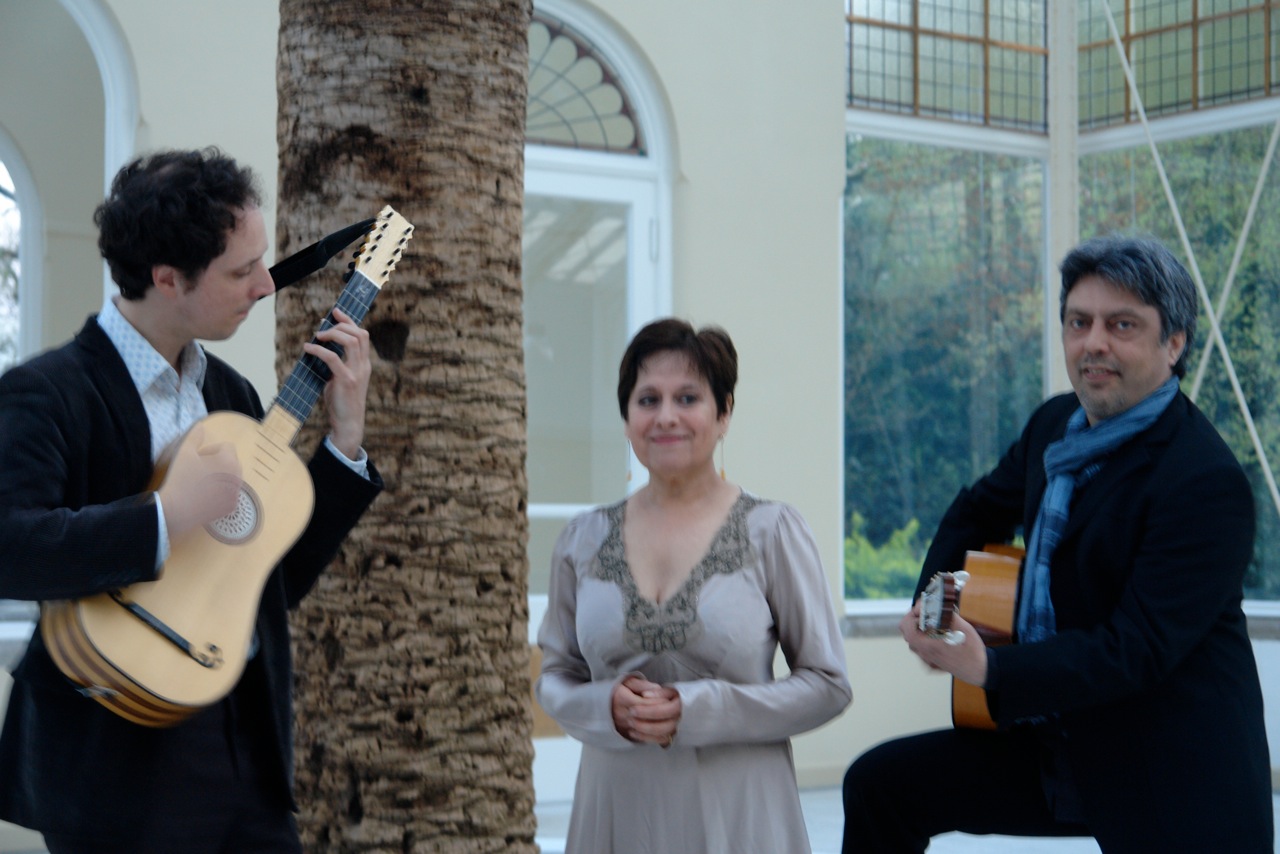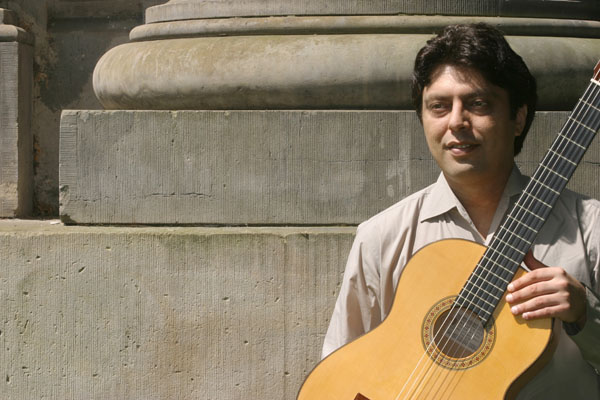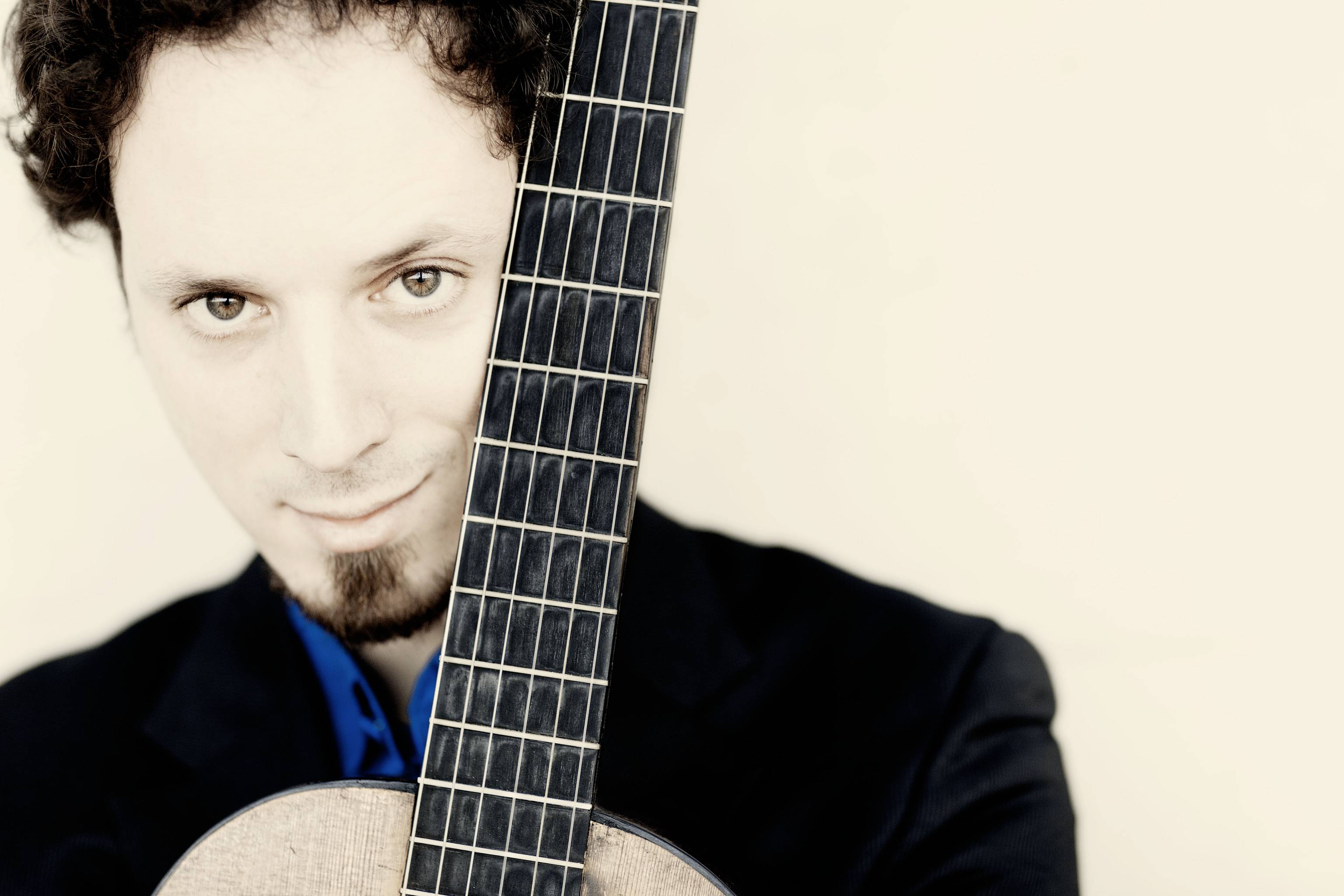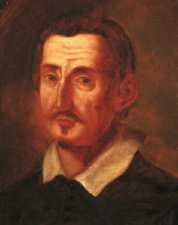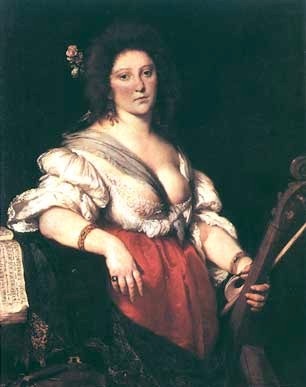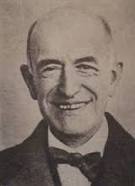The Flamenco Baroque Trio: Sonja van Lier – sopraan, Adrian Elissen – flamencogitaar en Izhar Elias – barokgitaar
16 februari 2014 | 16.45 uur
| ,
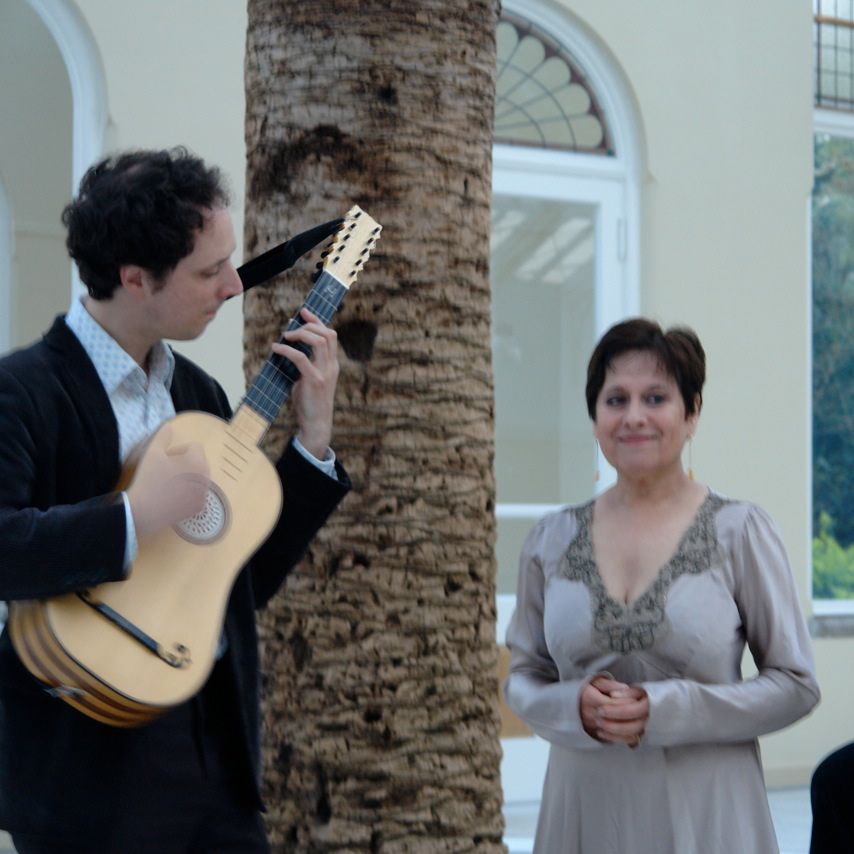
Spanish & Italian Fusion: Caccini, Sances, Frescobaldi, Marín, Merula, Corbetta, Strozzi, de Murcia, de Falla, Lorca en Flamenco
Het idioom van de liederen, dat het Flamenco Baroque Trio brengt, is van alle tijden en bevat een geïnspireerde mix van wiegenliederen, liefdesliederen, dansen en pasacaglia’s uit de vroege zeventiende eeuw van Spanje en Italië. Veelal werd in deze eeuw de luit en barokgitaar gebruikt als begeleidingsinstrumenten bij zang. Mede door dit feit bevindt zich zowel in Italië als in Spanje een grote schat aan repertoire, dat je zelden of weinig hoort.
Met het gebruik van flamencogitaar en het heldere geluid van de barokgitaar samen, komen er dimensies bij die elk lied uniek maakt. Deze combinatie is subliem gebleken. Zo kreeg door de arrangementen van Adrian en Izhar elk lied een ander karakter.
Een grote variatie van stijlen, dichters, componisten en folklore-elementen bepaalt het repertoire: Spanje en zijn dramatische oorlog tegen de Moren, geheime liefdesverhalen en speelse liefdesliederen; en de ‘fine fleur’ van het Italiaanse humanisme met zijn prachtige componisten en dichters. Zo kwam het Flamenco Baroque Trio al snel uit bij de Italiaanse en Spaanse vroege barok.
Het Flamenco Baroque Trio is ontstaan na een samenvoeging van klassiek gitarist Izhar Elias bij het Lorca Duo. Het Lorca Duo wordt gevormd door sopraan Sonja van Lier en de flamencogitarist Adrian Elissen. Het duo voorzag eenvoudige liederen van Federico García Lorca van begeleidingen en ritmes uit de Flamenco Puro. Het werk van het Lorca Duo sluit daarom naadloos aan op dat wat het Flamenco Baroque Trio met de liederen uit de zeventiende eeuw wilde beogen.
Programma: Spanish & Italian Fusion
Anoniem: Improvisatie en bewerking Follia
Izhar Elias / Adrian Elissen
Giulio Caccini (1551-1618): Odi, Euterpe’l dolce canto
Girolamo Frescobaldi (1583-1643): Se l’aura spira
Féderico García Lorca (1898-1936): El vito / Adrian Elissen
Francesco Corbetta (1616-1681): Chaconne in C
Teksten bij het programma: Spanish & Italian Fusion
Giulio Caccini: Odi, Euterpe (Dance song
Listen, Euterpe to the sweet song Love has put in my mouth,
and to that sweet song has tuned the golden tone of my lyre:
I am pressed by a love too sweet
to say what he tells me.
My Lydia covered her breast with the chaste veil of night,
But the moon high in the heavens uncovered it for me,
So I might admire such lovely treasure lit with flames of gold.
I saw the white snows of her opened breast,
And my languishing heart leaped to be
Between one snow and another.
I gazed and you wounded sweetly, O Lydia.
I urged and you robbed me of the view of your breast,
In a tiny spark, you a thousand flames.
But my heart burned so sweetly,
That every flame and every dart and that dear breast of love
Still refreshed my gaze and my wounded heart
Was a gently invitation to more wounds.
Giovanni Felice Sances: Usurpator
Lament on the passacaglia
Let another be usuper, tyrant
of your freedom, Lilla.
That from your commands
My love has no loss or hurt.
The jealous lover can assure that
I do not hear you, my love, nor see you,
My sighs will be
In spite of the constant lover.
He may assure that I be
An exile from your love and from my heart
But he cannot make my heart
Ever abandon your love.
Although he cries out his disdain
In his passion
The fool cannot stop me loving you
Even if you do not love me.
What use is it that my rival cannot
Prevent me desiring you
If adoration and love cannot
Stop me loving you?
The aim of your pleasures
Is now a new lover, handsome and happy,
To whom your wish allows and permits
The secret accents of the heart.
Whatever happens,
I will adore, as I have adored, your name,
Your eyes, your hair,
Will be both light and bonds to my heart.
Be cruel then, Lilla,
Try me with anguish and suffering:
The years will give me nothing else
But the reputation of faithfulness.
Girolamo Frescobaldi: Se l’ aura spira
When the lovely breezes blow,
The fresh rose stand smiling.
The hedge, a shady emerald, fears not
the summer’s heat.
Come, dance and be merry, dear nymphs,
Blossoms of beauty!
Now, the lovely, clear spring flows
From the mountain to the sea,
The bird sings its sweet notes
and the bushes are full of blossoms.
Only a face near the edge of darkness
Knows how to show compassion.
Come and sing, ye nymphs
And disperse the winds of cruelty!
José Marín: Que dulcemente sueno
De componist José Marín (van wie ook de tekst is), zat op dat moment na een veroordeling, gevangen in een toren. Het is een treurzang om zijn eigen lot. Meer informatie over José Marín, zie onder aan de pagina.
Hij bezingt zijn droevig lot,
een lot welk bepaalt niet te benijden is.
Zijn lot is onbuigzaam en onomkeerbaar.
Zijn klaagzang (llanto) is zijn zuchten
en zijn zuchten zijn kompas.
Hij voelt zich te kort gedaan.
Alleen omdat hij als een man van eer heeft gehandeld,
zijn de lafaards met de eer gaan strijken
en werd hij veroordeeld.
De laurierkransen zijn blijkbaar alleen
voor lafaards gemaakt.
Hij is zelfs jaloers op de vogels buiten de toren.
Hoe lieflijk klinkt tussen deze groene treurwilgen
deze levende luit.
Maar dan stopt hij met zijn droevige klaagzang (llanto)
en luistert naar de nachtigaal, die zacht kwinkeleert
No piense Menguilla ya / Don’ t flatter yourself Menguilla
In dit lied wordt een jonge luchthartige vrouw beschreven,die haar trouwe geliefde minacht en die altijd meer liefde neemt van haar dan ze geeft.
Don’ t flatter yourself Menguilla
That I am dying for your eyes,
For though a fool I may have been
I vow my folly to revise.
The apple of my eye she was, it’s true
Though she was but a windfall, one of few,
to counternance the Phoenix she demurred
because of his uniqueness she had heard.
Menguilla has no taste at all,
In Bedlam it seems bred.
For her desire is but a whim,
No reason governs her fair head.
She whose’ s beauty’ s value undermines
And of all vanity would be exempt
As familiarity does breed contempt,
The very devil she can be oft-times.
The one-armed man nor yet the man
Who’ s lame is no less biased,
No less to fancy prey and though scant beauty does attend
His frame to him has licence none the less a claim.
Refrain:
Such pretty manners hers
It is no wonder
She is passed from one man to another.
Manuel de Falla: Al paño moruno
Op de Moorse doek die in de winkel lag, zat een vlek.
Omdat hij nu zijn waarde verloren heft wordt hij voor minder geld verkocht.
Asturiana
Omdat ik verdrietig was zocht ik een groene pijnboom op om
eronder te zitten voor troost.
Toen de pijnboom mij zag huilen, huilde hij met me mee
En de groene pijnboom, huilde met me mee.
Féderico García Lorca: El vito
An old woman is worth a real1
and a young girl two cuartos2,
but as I am so poor
I go for the cheapest.
On with the dancing,
on with the dancing, ole!
Stop your teasing, sir,
else I’ll blush!
Tarquinio Merula: Hor ch’e tempo dormire
Spirituale sopra alla nana
(Cradle song of the Virgin Mary
Sacred song on a lullaby /
Geestelijk Wiegenlied
Wiegenied van de Maagd
Now that it’s the time for sleep,
Sleep, my son, and do not cry,
For the time will come
When you will have to weep.
My beloved, my love,
Sing lullaby.
Close those heavenly eyes
Just as other children do,
For soon a veil of darkness
Will take the light from the sky.
Or take this milk
From my untouched breasts,
For a cruel servant
Has vinegar and gall waiting for you.
My love, may my breast
Be for you now a soft bed,
Before you raise your voice and render
Your soul to your Father, on the Cross.
Rest now your lovely,
Tender, graceful little arms,
For later shackles and chains
Wilt cause them bitter pain.
These hands and feet,
That you joyfully love to look on now,
Alas, sharp nails will pass
Through them in different ways!
These graceful features,
Now ruddier than a rose,
Will be marked by spits and slaps
In agony and distress.
Ah, causing you such pain,
My heart’s only hope,
Your forehead will be pierced
By sharp thorns.
Ah, in your divine breast
My sweet love and delight,
A cruel, treacherous spear
Will strike a fatal blow.
So sleep, my son,
Sleep on, my Redeemer,
For with smiling faces
We shall meet in paradise.
Now that my love, true joy
Of my heart, lies sleeping,
Let all be sure to be silent,
Even heaven and earth.
And meanwhile what shall I do?
I shall gaze on my love.
I shall stay with my head bowed
As long as my Baby sleeps.
Barbara Strozzi: Che si puo fare
What can one do if the rebel stars have no pity;
What can be done if heaven has no peaceful influence to soothe my sorrow;
What can one say from the stars disasters rain upon me at all hours;
What can be said if perfidious love denies the slightest repose to my martyrdom;
What can be said? That is how it goes with perverse destiny, that condemns the innocent,
So too constancy that most trusted gold and oh, it nonetheless
Need be purified at every hour by the flames of my sorrows.
Yes, yes I should suffer, yes from my sighs I should hold back my breath.
In bitter misfortunes so as to prolong my being, the heavens deny me my destiny, that my life’s course should lead to death.
Cursed spirits, you do rejoice indeed,
when each of the perverse furies has as its only goal the torment of soul.
If the furies of Dis were to vanish,
You would spend your days in the eternal Elysia,
While I perish in the underworld.
So it happens to him who must follow the example of the blind man:
In the end he falls to the ground.
Féderico García Lorca: Sevillanas del siglo XV111
Long live Seville!
The ladies of Seville
Carry in their mantillas
A sighn saying:
Long live Seville!
Long live Triana!
Hurrah for those from Triana,
The inhabitants of Triana!
Hurrah for the men and
Women of Seville!
I carry it with me as I go,
The Virgin of the Macarena and all,
I take it with me.
I take it with me everywhere
Never have I seen
A face like yours.
How lovely you are!
Oh river of Seville,
How lovely you are,
Full of white sails
And green tranches!
Viva Seville!
Sonja van Lier – sopraan
De sopraan Sonja van Lier volgde haar opleiding aan het Utrechts Conservatorium en behaalde daar haar solistendiploma. Zij studeerde liedrepertoire bij Elly Ameling, Robert Holl en de pianist Thom Bollen, met wie zij jarenlang tevens jarenlang een duo vormde. Ze begon haar carriere in de musical in het buitenland, waar ze o.a. in West Side Story zong.
Zij debuteerde als Ninetta in La Finta Semplice van Mozart bij Opera Forum, specialiseerde zich in kamermuziek en maakte diverse radioopnames.
In 1995 zong zij tijdens een speciaal concert ter gelegenheid van de 5O-jarlge Bevrijding in Washington voor genodigden van het Witte Huis. De bekende zanger Robert Holl nodigde haar uit voor de Schubertiade in Wenen en Rotterdam. Haar specialisatie is het Spaanse lied. Met het Radio Symfonieorkest nam zij Spaanse liederen op van Rodrigo, Montsalvatge en Villa Lobos en met het Radio Kamerorkest liederencycli van Dallapicola. Plaatopnames van het Gloria van Poulenc en liederen van Nederlandse componisten.
In Amsterdam (Concertgebouw Kleine Zaal) Parijs,Geneve, Singapore, Kuala Lumpur en Jakarta gaf zij liedrecitals. In februari 2006 maakte Sonja van Lier voor de achtse maal een tournee door Indonesië waar zij in dit geval met haar begeleider Vaughan Schlepp op uitnodiging van de Nederlandse Ambassade gseconcerteerd heeft.
Zij heeft als sopraan meer jarenlang deel uitgemaakt van verschillende vocale ensembles bij de radio ook als soliste en zong jarenlang als (free-lance) sopraan in het Nederlands Kamerkoor. Sonja van Lier is daarnaast ook zangpedagoge; tot haar zangleerlingen behoorden o.a. Joke de Kruif, Marjolein Keunig, de sopraan Anitra Jellema en de popzanger Jaco van der Steen. Met musicus Vaughan Schlepp vormt Sonja van Lier een geïnspireerd duo dat kleurrijke, vernieuwende (o.m. Spaanse) programma’s brengt. Zij is tientallen jaren soliste bij de Vereniging Vrienden van het Lied.
www.stichtingkamermuzieksoestdijk.nl
Adrian Elissen, Flamencogitarist
De flamencogitarist Adrian Elissen is vandaag de dag bezig met een internationale solisten carrière op te bouwen en geeft concerten op binnen- en buitenlandse podia, zoals een solorecital in het concertgebouw te Amsterdam, het 11de Internationale Percuba 2000 festival (Havana, Cuba) Cemal Resit Rey Concert Hall en International Bursa Festival (Istanboel, Bursa,Turkije) en de Homenaje a José Luis Postigo (Córdoba, Spanje)
Onlangs is zijn eerste solo cd verschenen; Nubes y Claros. Adrian volgde zijn opleiding aan het Rotterdams Conservatorium bij Paco Peña waar hij in 2001 cum laude zijn tweede fase/ solisten diploma behaalt. Hij heeft in het verleden talrijke muziekbeurzen toegekend gekregen van het Fonds voor de Podiumkunsten, het Prins Bernhard Fonds en van de Fundación de arte Flamenco Cristina Heeren (Spanje) waar hij in 2002 cum laude voor het examen slaagt. Ook begeleide hij flamencozangers op talrijke concoursen en heeft hij veelvuldig in peña’s (flamencocentra) gespeeld waar zijn voorliefde voor de oorspronkelijke flamencozang tot uiting komt.
In 2003 is hij gecontracteerd in Spanje waar hij deel uitmaakt van de companía van de gitarist Juan Ramón Caro (Maíte Martín, Belén Maya). Hij is uitgenodigd als solist een aantal concerten in Turkije en België te geven en als begeleider door flamencodanser Andrés Marín en Bienal winnares Laura Vital. Ook geeft hij leiding aan een Soefi/flamenco programma samen met musici van Radio Istanboel waarmee hij een nieuwe tournee door Nederland realiseert in maart 2009. (o.a in de nieuwe muziekgebouw aan t ij, Meervaart en De Leidsche schouwburg)
Hij heeft radio- en cd opnamen in o.a. Spanje en Duitsland gemaakt en werkte daarbij vaak samen met musici uit de jazz en klassieke muziek, hetgeen resulteerde in een platen contract bij het Duitse label WorldNetwork. Naast zijn werkzaamheden als uitvoerend musicus geeft Adrian lessen en workshops in sologitaar en begeleiding van zang en dans. Hij heeft les gegeven aan het Taller Flamenco (Sevilla). In 2004 was hij externe deskundige in de eindexamencommissie van het Rotterdams Conservatorium samen met Paco Peña. Hij treedt op als solist of met zijn trio en in uitgebreide formaties met zang en dans. Met de sopraan Sonja van Lier heeft hij deel uitgemaakt van het Lorca Trio en tot heden het Lorca Duo.
www.adrianelissen.com
Izhar Elias – klassiek gitarist
Izhar Elias’ verhalende en poëtische stijl en zijn grensverleggende programmering heeft hem inmiddels wereldwijde bekendheid gebracht. Zijn veelzijdigheid als gitarist komt tot uiting in door zijn verdieping in de historische uitvoeringspraktijk (barok en vroeg 19e eeuw), de kamermuziek en de hedendaagse muziek gecombineerd met multimedia.
20 maart 2011 ontving hij de prestigieuze Nederlandse Muziekprijs, als allereerste gitarist in de geschiedenis van de prijs. De Nederlandse Muziekprijs is de hoogste staatsonderscheiding die aan een musicus, werkzaam in de klassieke muziek, kan worden uitgereikt. Na zijn uitvoering van Joaquín Rodrigo ́s beroemde Concierto de Aranjuez met het Residentie Orkest (maart 2011) prees de Telegraaf zijn spel met: “De kracht van zijn dwingende en heldere subtiliteiten overwon.”
Izhar Elias behaalde meerdere prijzen tijdens diverse nationale en internationale concoursen. Elias gaf tal van concerten in Europa, Rusland, Zuid-Oost Azië en Australië.
In juni 2009 bracht hij een wereldpremière opname uit met vroeg 19e eeuwse arrangementen van Rossini ́s opera ‘Semiramide’, gespeeld op zijn unieke Guadagnini gitaar uit 1812. ‘Elias doet met versieringen en al, niet onder voor welke diva dan ook’, aldus Peter van der Lint van Dagblad Trouw naar aanleiding van deze dubbel CD.
Elias werkt regelmatig samen met componisten, choreografen, filmmakers en theater regisseurs. Zijn vernieuwende CD plus DVD ‘Big Eye’ werd in Gramophone geprezen met de woorden ‘Wacky, irreverent and thought provoking’. Met Ensemble Cordevento, dat zich vooral richt op repertoire uit de 17e eeuw, is Elias regelmatig op tournee in Nederland, België, Rusland en Bulgarije. Voor seizoen 2011-2012 is Cordevento opgenomen in de ‘Rising Stars’ serie, met o.a. optredens in Keulen, Hamburg, Wenen, Brussel en Luxemburg.
Izhar Elias (Amsterdam, 1977) kreeg vanaf zijn zevende jaar gitaarles van Ton Terra aan de Muziekschool Amstelveen. Hij studeerde aan de conservatoria van Groningen en Den Haag, bij het Groningen Guitar Duo en bij Zoran Dukic. In 2002 sloot hij zijn master opleiding af met een 9,5 met onderscheiding en de Nicolaï prijs. Elias volgde een opleiding aan de ‘Accademia di Studi Superiori l ́Ottocento’ bij Carlo Barone in Italië (uitvoeringspraktijk 19e eeuwse muziek). Bij William Carter en Adrián Rodriguez van der Spoel studeerde hij barokgitaar. Van de violist Kees Hendrikse kreeg hij interpretatielessen.
Izhar Elias beschikt o.a. over een originele gitaar uit 1812 (C. Guadagnini, Turijn), waarvan de aanschaf mede mogelijk werd gemaakt door het Prins Bernhard Cultuurfonds.
www.izharelias.com
José Marín – componist:
“José Marín, an ambiguous and fascinating personality, a Spanish composer, guitarist and singer, was born in 1618 or 1619. He entered holy orders in Rome; in 1644 he joined the Chapel of the Monasterio de la Encarnación, in Madrid as a tenor. He was placed under arrest in 1654 and again in 1655. Accused of assault, robbery and murder, he was tortured, secularized and imprisoned.”
José Marín’s tonos humanos, thus summarising the few biographical data that are available of one of the certainly most prolific composers of tonos humanos (profane songs in Romance languages) of the Spanish Baroque. Many compilations of tonos humanos kept in several places of the world (New York, Madrid, Santiago de Compostela, Venice, San Francisco…) include works by him, which gives us a hint of the celebrity and dissemination that his songs achieved. Moreover, he is the only composer of tonos humanos to which a complete manuscript has been dedicated, including fifty-one compositions by him, the so-called Fitzwilliam Manuscript, kept in Cambridge, which was studied in the aforementioned edition.
Without enlarging too much on the definition of tono humano, we will say that it is a profane composition developed in Spain over the seventeenth century; the qualification of humano (human) is attributed in distinction from tono a lo divino (sacred tune). In the first half of that century, the tonos humanos were basically polyphonic, whereas in the second one, they tended to be monodic. The tono is made up of a chorus
(*) José Marín 1619-1699, 51 tonos para voz y guitarra. Edited by A. Lázaro. Chantarelle Verlag, 1997.
Félix Rienth Alluethat alternates with a certain number of stanzas. Its origins are varied, like its use, but it is basically twofold: it comes from plays, or it was composed as a chamber song. It is also possible that both uses overlapped, and that the choruses popularised by the theatre were used as the basis for composing the tonos with new stanzas by glossing previous versions.
The usual instruments for accompanying these pieces were basically two: the guitar and the cross-strung harp. The musical sources that have been kept and the many literary references are proper proof of it. Although both instruments were very often used together, the accompaniment of just one of them is most probably the most effective way of making the text –extremely important in these compositions– more understandable, and the hidden harmonic subtleties, rhythmical, rhetorical and melodic, of this repertoire to appear.

